Related Research Articles

Honoré de Balzac was a French novelist and playwright. The novel sequence La Comédie humaine, which presents a panorama of post-Napoleonic French life, is generally viewed as his magnum opus.

James Fenimore Cooper was an American writer of the first half of the 19th century, whose historical romances depicting colonial and indigenous characters from the 17th to the 19th centuries brought him fame and fortune. He lived much of his boyhood and the last fifteen years of life in Cooperstown, New York, which was founded by his father William Cooper on property that he owned. Cooper became a member of the Episcopal Church shortly before his death and contributed generously to it. He attended Yale University for three years, where he was a member of the Linonian Society.

The Leatherstocking Tales is a series of five novels by American writer James Fenimore Cooper, set in the eighteenth-century era of development in the primarily former Iroquois areas in central New York. Each novel features Natty Bumppo, a frontiersman known to European-American settlers as "Leatherstocking", "The Pathfinder", and "the trapper". Native Americans call him "Deerslayer", "La Longue Carabine", and "Hawkeye".

La Comédie humaine is Honoré de Balzac's 1829–48 multi-volume collection of interlinked novels and stories depicting French society in the period of the Restoration (1815–30) and the July Monarchy (1830–48).

Les Chouans is an 1829 novel by French novelist and playwright Honoré de Balzac (1799–1850) and included in the Scènes de la vie militaire section of his novel sequence La Comédie humaine. Set in the French region of Brittany, the novel combines military history with a love story between the aristocratic Marie de Verneuil and the Chouan royalist Alphonse de Montauran. It takes place during the 1799 post-war uprising in Fougères.
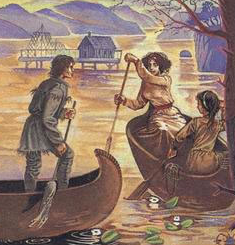
Nathaniel "Natty" Bumppo is a fictional character and the protagonist of James Fenimore Cooper's pentalogy of novels known as the Leatherstocking Tales.
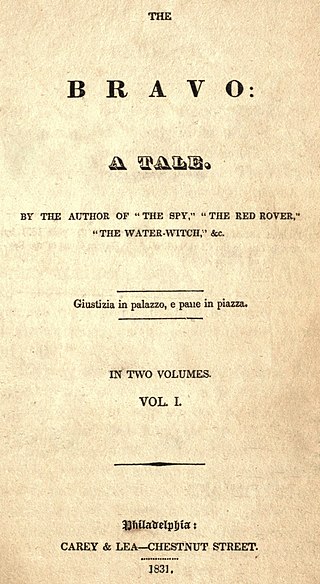
The Bravo is a novel by James Fenimore Cooper first published in 1831 in two volumes. Inspired by a trip to Europe where he traveled through much of Italy, the novel is set in Venice. The Bravo is the first of Cooper's three novels to be set in Europe. This group of three novels, which one critic would call Cooper's "European trilogy", include The Heidenmauer and The Headsman. Like his other novels set in Europe, The Bravo was not very well received in the United States. The book largely focuses on political themes, especially the tension between the social elite and other classes.
The Chainbearer; or The Littlepage Manuscripts is a novel by the American novelist James Fenimore Cooper first published in 1845. The Chainbearer is the second book in a trilogy starting with Satanstoe and ending with The Redskins. The novel focuses mainly on issues of land ownership and the displacement of American Indians as the United States moves Westward.
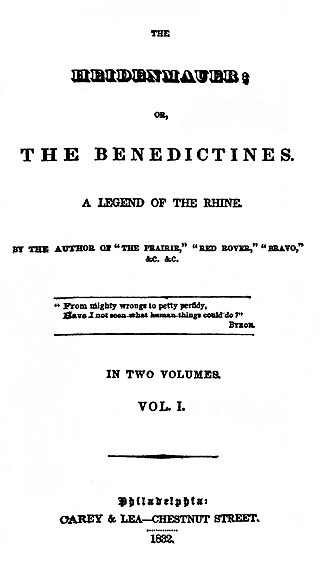
The Heidenmauer; or, The Benedictines – A Story of the Rhine is a novel by James Fenimore Cooper, first published in 1832. The novel is a socio-political novel set in 16th-century Germany that focuses on the competition between various socio-political classes and the tension caused by the Reformation. The Heidenmauer is Cooper's second novel in what one critic would call his European Trilogy, following The Bravo and preceding The Headsman. Like the other novels set in Europe, The Heidenmauer is intent on showing the darker side of European institutions in favor of an American perspective.
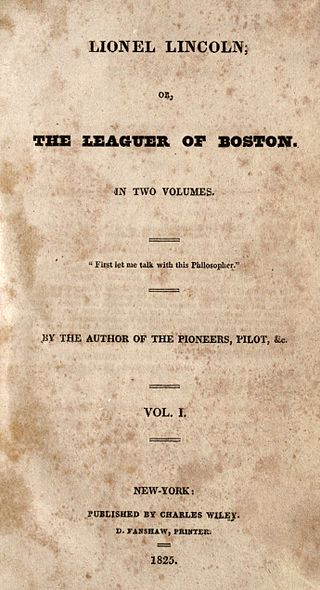
Lionel Lincoln is a historical novel by James Fenimore Cooper, first published in 1825. Set in the American Revolutionary War, the novel follows Lionel Lincoln, a Boston-born American of British noble descent who goes to England and returns a British soldier, and is forced to deal with the split loyalties in his family and friends to the American colonies and the British homeland. At the end of the novel, he returns to England with his wife Cecil, another American born cousin.
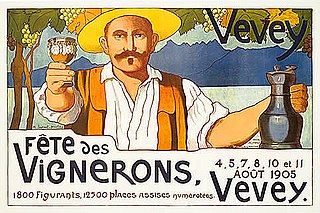
The Fête des Vignerons is a traditional festival which takes place in Vevey, in Switzerland.

Nautical fiction, frequently also naval fiction, sea fiction, naval adventure fiction or maritime fiction, is a genre of literature with a setting on or near the sea, that focuses on the human relationship to the sea and sea voyages and highlights nautical culture in these environments. The settings of nautical fiction vary greatly, including merchant ships, liners, naval ships, fishing vessels, life boats, etc., along with sea ports and fishing villages. When describing nautical fiction, scholars most frequently refer to novels, novellas, and short stories, sometimes under the name of sea novels or sea stories. These works are sometimes adapted for the theatre, film and television.
Afloat and Ashore is a nautical fiction novel by James Fenimore Cooper first published in 1844. Set in 1796–1804, the novel follows the maritime adventures of Miles Wallingford Jr., the son of wealthy New York landowners who chooses to go to sea after the death of his parents. The novel ends abruptly part way through, and is followed by what critic Harold D. Langely called a "necessary" sequel which resolves many thematic and plot elements. The novel is partially autobiographical, based in part on Cooper's own experiences as a sailor, and is his first full-length novel to fully employ a first-person narrative.

Mercedes of Castile; or, The Voyage to Cathay is an 1840 historical novel by James Fenimore Cooper. The novel is set in 15th-century Europe, and follows the preparations and expedition of Christopher Columbus westward to the new world.

The Water-Witch is an 1830 novel by James Fenimore Cooper. Set in 17th-century New York and the surrounding sea, the novel depicts the abduction of a woman, Alida de Barbérie, by the pirate captain of the brigantine Water-Witch, and the subsequent pursuit of that elusive ship by her suitor, Captain Ludlow.
The Two Admirals is an 1842 nautical fiction novel by American author James Fenimore Cooper. The novel was written after the Leatherstocking Tales novel The Deerslayer. Set during the 18th century and exploring the British Royal Navy, Cooper wrote the novel out of encouragement of his English publisher, who recommended writing another sea novel. Cooper had originally intended to write a novel where ships were the main characters, though eventually decided not to. The novels is one of three novels which Cooper would revise for editions following their first printing, the other two being The Pathfinder and Deerslayer.
Autobiography of a Pocket Handkerchief is a serial novel by James Fenimore Cooper first published by Graham's Magazine in 1843. The novel explores the upper crust of New York Society from the perspective of a woman's handkerchief.
Wyandotté is a historical novel published by James Fenimore Cooper in 1843. The novel is set in New York state during the American Revolution. The main character of the novel is an Indian, "Saucy Nick", also called Wyandotté, whose depictions violate stereotypes of Native Americans.
Notions of the Americas; Picked Up by a Travelling Bachelor is an 1828 semi-nonfictional travel narrative by James Fenimore Cooper. The work takes the form of letters between a fictional bachelor traveling in the United States to his European friends. Cooper wrote the work while in Europe, and originally published the work anonymously, to conceal his identity and be more convincing to European audiences. The book persuasively argues for the virtue of American values and democracy in comparison to the aristocratic values of Europe.
Joseph Hardman was an English merchant and contributor to Blackwood's Magazine.
References
- ↑ "Checklist of Cooper's Works". external.oneonta.edu. Retrieved 2016-03-08.
- ↑ Cooper, Susan Fenimore (1861). "Introduction to The Headsman". external.oneonta.edu. Retrieved 2016-03-08.
- ↑ MacDougall, Hugh (2013). "Cooper's The Headsman: What Have Swiss Executioners Got to Do with African-Americans?". James Fenimore Cooper: His Country and His Art, Papers from the 2013 Cooper Conference and Seminar: 29–35.
- ↑ Franklin, Wayne (2017). "Republican Principles". James Fenimore Cooper: The Later Years. New Haven: Yale University Press. pp. 139–141. doi:10.12987/9780300229103-007. ISBN 9780300229103.
- 1 2 3 4 Denne, Constance Ayers (1974-01-01). "Cooper's Artistry in The Headsman". Nineteenth-Century Fiction. 29 (1): 77–92. doi:10.2307/2933407. JSTOR 2933407.
- ↑ Pudaloff, Ross J. (1983-01-01). "Cooper's Genres and American Problems". ELH. 50 (4): 711–727. doi:10.2307/2872924. JSTOR 2872924.
- ↑ Denne, Constance Ayers (July 1980). "Cooper's Use of Setting in the European Trilogy". 3rd Annual Cooper Seminar: 52–70.
- ↑ Palfrey, Thomas R. (1932-01-01). "Cooper and Balzac: "The Headsman"". Modern Philology. 29 (3): 335–341. JSTOR 433617.